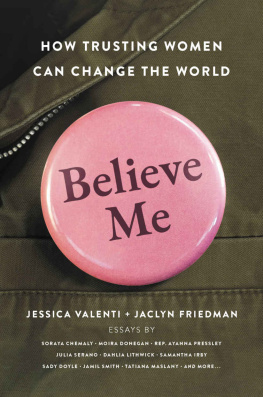FULL FRONTAL FEMINISM


Full Frontal Feminism
A Young Womans Guide to Why Feminism Matters
Second Edition
Copyright 2007, 2014 by Jessica Valenti
Published by
Seal Press
A member of the Perseus Books Group
1700 Fourth Street
Berkeley, CA 94710
All rights reserved. No part of this book may be reproduced or transmitted in any form without written permission from the publisher, except by reviewers who may quote brief excerpts in connection with a review.
ISBN-13: 978-1-58005-572-7
Library of Congress Cataloging-in-Publication Data
Valenti, Jessica.
Full frontal feminism : a young womans guide to why feminism matters
/ Jessica Valenti.
p. cm.
Includes bibliographical references.
1. Feminism. 2. WomenSocial conditions21st century. I. Title.
HQ1155.V35 2007
305.42dc22
2006038573
10 9 8 7 6 5 4 3 2 1
Cover design by Faceout Studio, Emily Weigel
Interior design by Megan Cooney
To Miss Magoo
CONTENTS
When I wrote Full Frontal Feminism over five years ago, I couldnt have imagined the response it would get. Its the best-selling book Ive written, the one I get the most emails about and the one that seems to have had the most impact. Young women still come up to me and tell me that FFF is the book that made them realize they were a feminist. Thats a wonderful feeling.
FFF is also a book thats received a lot of criticisma lot of it fair, some of it not (in my humble opinion!). And while five years is a relatively short amount of time to have passed after writing a book, in feminist yearsconsidering how much has happened in politics, society, and the movementit feels like forever. Thats why Im so grateful to have the opportunity to republish the book with this new introduction. It gives me the chance to check in with readers, address some of the gaps in the book, and add updates to various issue areas. Because, lets face it, a lot has happened!
But first things first: You may have noticed that the cover of the book is different than the original.
Weve changed it because the original cover doesnt reflect the kind of feminism I believe in or would like for the world. The original artfeaturing a toned white stomach with books title scrawled across itcentered a particular kind of woman as feminist and perpetuated the idea that feminism is largely for white women. At the time, I looked at the cover image and thought of Kathleen Hanna writing the word SLUT on her stomach. I thought of it as reclaiming the female body. Thanks to the privilege I enjoy as a white person, I could look at that stomach, at the cover, and feel it spoke to mebecause most images look like me, are relatable, and address who I am because of the culture we live in that centers white as normal. Im sorry that the books cover made some women feel that FFFor feminismwasnt for them. Its a hurt I cant undo, but Im thankful that future editions of the book will have a new cover.

Another glaring gap in the book was the absence of trans issues and activism. When I wrote the book, trans issues werefor the most part, and wronglynot seen as an integral part of feminism. Transfeminism was largely absent from womens studies classes, feminist texts, and widely fought feminist issues. Even discussions of intersectionalityfighting racism, classism, and homophobia along with sexismoften didnt include discussions of trans issues. For me, it was reading Julia Seranos Whipping Girlreleased the same year as FFFthat changed my feminist world. Im so glad that todaythanks in large part to people like Julia and trans feminists onlinetrans issues and the discrimination and structural violence against trans people has become such a central part of feminism. Theres still much work to be doneby me includedbut I believe were on the right track.
FFF was also criticized for its informal tone and, lets face it, my penchant for dropping the f-bomb and other assorted curses and colloquialisms. I admit, while re-reading the book I cringed a bit at my languagebut hey, Im in my mid-thirties now and have a different perspective than I did in my late twenties. I can understand why a more conversational tone might not be for everyone, but I actually think this was one of the reasons why the book resonated with so many young women. Thats how I talked when I wrote the book! One of my hopes for FFF was that it would be accessible, that it would feel like listening to a friend. And though I do have a graduate degree in Womens and Gender Studies, I reject the idea that feminism needs to be couched in academic language in order to make it relevant or important. So long live f-bombs!
Probably the most amazing thing that has happened since FFF was first published is the absolute explosion of online feminism. When I was writing FFF, I was just two years into having founded Feministing.com. More feminist blogs were cropping up every day, but the feminist blogosphere was still a relatively small place. And social media hadnt taken off yetTwitter had just been founded, Facebook was still a closed network, and Tumblr didnt exist. The rise of these mediums in the last few years has meant that feminism and feminist voices have been amplified in a way we never could have imagined. Weve seen President Barack Obama elected (twice!), watched as the war on women dominated the media, and seen young feminist activists take the helm online and off.
The rise of insurgent feminist voices combined with a political climate that has become increasingly centered around womens issues has made for a very interesting few years for feminists! For every chapter I wrote, every issue I addressed, there have been setbacks and successes, new thoughts and actions. Ive included some (because theres certainly not enough room for all!) at the beginning of each chapter. Id like to think of these as a bit of a catch-up on individual issues.
Broadly speaking, however, I have to say that the years since FFF came out have been some of the most exciting Ive experienced as a feminist. My hope and vision for more young women calling themselves feminists has become more of a reality every day. And my fears of a feminist movement controlled by a few elite powerful folks at the heads of mainstream organizations have become more and more quelled as online feminists and individual feminist activists and voices gain more traction in feminist spaces and the mainstream world. While weve suffered setbacks, feminism has come an incredibly long way in a short amount of time. Im so grateful that I got to be a part of that through blogging and writing, and Im hopeful that Ill continue to be able to do this workalongside all of youfor years to come.
This is what a feminist looks like
One of the most incredible things about the last few years is the increase of young women publicly identifying as feminists. Yes, the anti-feminist stereotypes still exist, but with the advent of online feminism, those myths have become much easier to debunk. One of my favorite stories to tell when I speak on college campuses is of a teenage girl who emailed Feministing and told us how she came to become a regular reader. She had done a Google search on Jessica Simpsonshe was a fanand ended up on Feministing because we had written a few posts on how creepy Simpsons dad was (virginity pledges, talking about her breasts, etc). She ended up sticking around because she liked what she saw.
Next page










